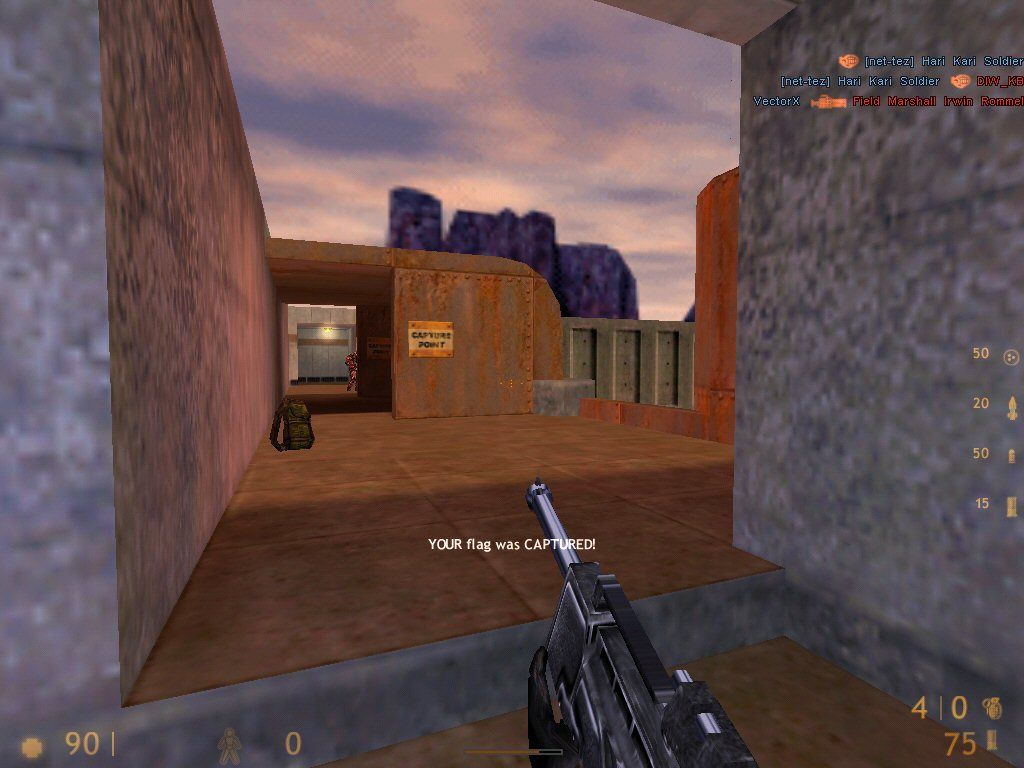Retro Replay Review
Gameplay
Team Fortress Classic excels in delivering fast-paced, team-oriented action through its nine unique classes, each tailored for specific battlefield roles. Whether you’re darting across the map as a nimble Scout to snatch the enemy flag or laying down suppressive fire with the Heavy Weapons Guy’s chaingun, the class design encourages cooperation and strategic synergy. The presence of melee weapons, firearms, and a variety of grenade types ensures that combat remains dynamic, rewarding both individual skill and coordinated team efforts.
(HEY YOU!! We hope you enjoy! We try not to run ads. So basically, this is a very expensive hobby running this site. Please consider joining us for updates, forums, and more. Network w/ us to make some cash or friends while retro gaming, and you can win some free retro games for posting. Okay, carry on 👍)
The game’s core modes—such as Capture the Flag, Assassination/Escort, and Territory Control—offer distinct objectives that demand different approaches from each class. Scouts are natural flag runners, relying on their speed and agility, whereas Demomen and Soldiers excel at breaching enemy defenses or creating diversions with explosive weaponry. Engineers add depth to gameplay by constructing sentry guns, teleporters, and ammo dispensers, effectively shaping the ebb and flow of skirmishes.
Balancing these nine classes is central to TFC’s enduring appeal. While some classes boast sheer firepower or speed, others offer critical support through healing (Medic), reconnaissance (Sniper), or subterfuge (Spy). Matches play out as a constant chess game, with teams adjusting their class composition on the fly to counter enemy tactics. The result is a well-rounded shooter experience that rewards communication and adaptability as much as aim and reflexes.
Graphics
Given its roots in the original Quake engine and later adaptation to Half-Life’s framework, Team Fortress Classic’s visuals are dated by modern standards but retain a clear, functional art style. Character models are brightly colored and exaggerated in silhouette, making it easy to distinguish friend from foe across varied map environments. The low-polygon count and simplistic textures allow the game to run smoothly on a wide range of hardware even today.
Map design contributes significantly to the game’s visual coherence. Environments are typically well-lit and logically laid out, with clear sightlines for Snipers and chokepoints for Demomen. Though not aiming for photorealism, the level geometry and color palettes strike a balance between readability and immersion. Players can quickly grasp spatial layouts, which is crucial in high-stakes moments like evading a relentless Scout or navigating to an enemy flag room.
Particle effects—such as rocket explosions, flamethrower flames, and grenade blasts—are punchy and easy to read amidst the chaos of firefights. Weapon tracers and hit indicators may look rudimentary by today’s standards, but they provide immediate feedback on combat actions. This clarity in visual cues enhances the satisfaction of landing a well-timed rocket jump or perfect sniper headshot.
Story
Team Fortress Classic does not offer a traditional single-player narrative; instead, it leans into emergent storytelling driven by players’ actions. The nine classes come with archetypal backgrounds and personalities—Scouts are cocky sprinters, Spies are cunning infiltrators, and Medics are eccentric healers—but behind these roles lies an open canvas for memorable moments. A perfectly executed backstab or a heroic rescue of a downed teammate can become the story of your match.
Multiplayer sessions organically craft little tales of rivalry and camaraderie. A team might rally around a valiant Soldier holding the last point, or a clutch Pyro might save the day by igniting an entire corridor of enemies. These unscripted events give each round its own narrative arc, making every session feel fresh despite the absence of a formal plot or cutscenes.
In lieu of a linear storyline, TFC fosters a strong player-driven lore through custom maps, community servers, and class-specific banter. The playful taunts exchanged between opposing teams (“Spy sneaks behind you!”) and the roar of victory after a successful defense can feel as engaging as any scripted campaign. This social dimension effectively becomes the “story,” one you write with teammates and adversaries alike.
Overall Experience
More than two decades after its release, Team Fortress Classic remains a testament to the enduring appeal of class-based shooters. Its straightforward mechanics, combined with deep strategic layers, have influenced a generation of multiplayer titles. While newer games tout fancy graphics and elaborate narratives, TFC’s pure focus on balanced combat and fun has ensured a loyal following that keeps servers active even today.
The learning curve is approachable for newcomers but offers plenty of room for mastery. Experimenting with different classes reveals unique playstyles and synergies, and community-run servers often feature custom maps and rule sets to spice up the experience. Frequent updates are no longer common, but a passionate modding community ensures fresh content and challenges.
For potential buyers, Team Fortress Classic represents both a piece of FPS history and a still-viable multiplayer arena. Its age shows in the visuals, but the core gameplay loop—choosing a class, coordinating with teammates, and outsmarting opponents—remains as exhilarating as ever. Whether you’re introducing friends to the roots of team shooters or exploring it solo, TFC offers a gratifying, competitive environment that has stood the test of time.
 Retro Replay Retro Replay gaming reviews, news, emulation, geek stuff and more!
Retro Replay Retro Replay gaming reviews, news, emulation, geek stuff and more!









Reviews
There are no reviews yet.